 House prices in the UK are rising and the rise seems to be accelerating – at least until the latest month (August). They are now growing at an annualised rate of nearly 4%. This is the fastest rate for three years (see chart below: click here for a PowerPoint of the chart).
House prices in the UK are rising and the rise seems to be accelerating – at least until the latest month (August). They are now growing at an annualised rate of nearly 4%. This is the fastest rate for three years (see chart below: click here for a PowerPoint of the chart).
This may be worrying for Mark Carney, the Governor of the Bank of England, who is committed to avoiding a new house price bubble. 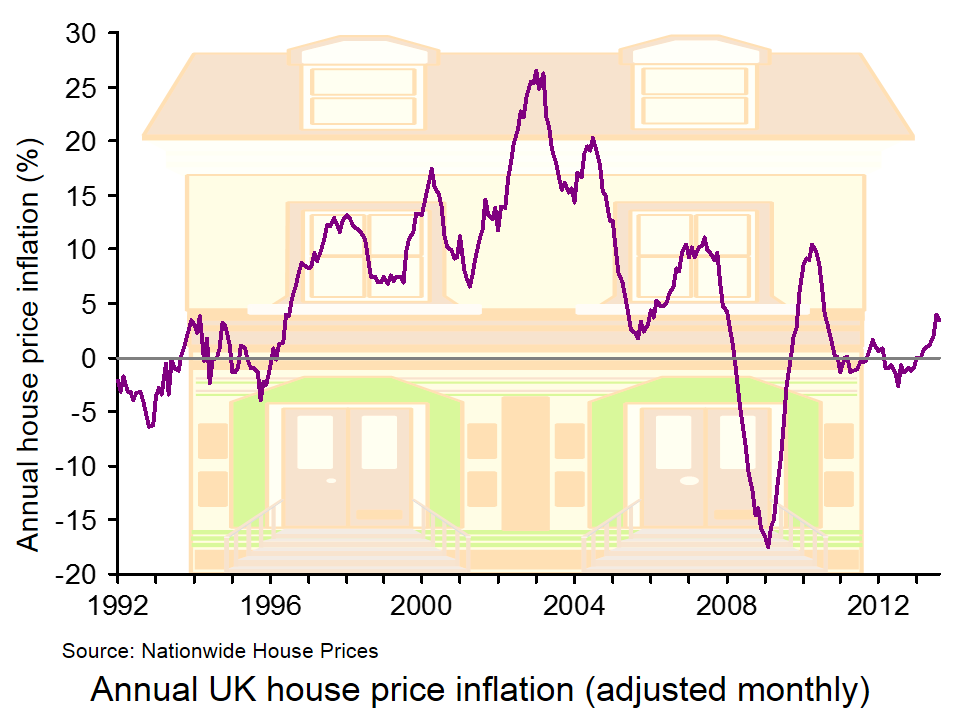 The problem is that, under the recently issued forward guidance, the Bank of England is set to retain the current historically low Bank rate of 0.5% until unemployment has fallen to 7%. But that could be some time – probably around two years.
The problem is that, under the recently issued forward guidance, the Bank of England is set to retain the current historically low Bank rate of 0.5% until unemployment has fallen to 7%. But that could be some time – probably around two years.
So what can the Bank do in the meantime and what will be the consequences?
The following article from The Guardian looks at the options.
Article
How can the Bank of England prick the house price bubble? The Guardian, Patrick Collinson and Heather Stewart (30/8/13)
Data
Links to house price data The Economics Network, John Sloman
Questions
- What constitutes a housing price boom? Is the UK currently experiencing such a boom?
- What factors have led to the recent house price rises? Have these factors affected the demand or supply of houses (or both)?
- Who gains and who loses from rising house prices?
- Explain the policy adopted in New Zealand to curb house price inflation.
- Consider the merits of this option?
- Could borrowers find ways around this measure?
- Are there any other options open to the Bank of England?
 In our blog How sustainable is UK consumer spending? we considered concerns of some commentators that consumer spending was growing unduly quickly given the absence of any sustained growth in disposable income. The Second Estimate of GDP, Q2 2013 reports that the economy grew by 0.7 per cent in the second quarter of the year, with household expenditure growing by 0.4 per cent.
In our blog How sustainable is UK consumer spending? we considered concerns of some commentators that consumer spending was growing unduly quickly given the absence of any sustained growth in disposable income. The Second Estimate of GDP, Q2 2013 reports that the economy grew by 0.7 per cent in the second quarter of the year, with household expenditure growing by 0.4 per cent.
Because household spending makes up about two-thirds of aggregate demand in the UK it is important to keep an eye on it. The latest figures show that the real value of consumer spending by British households has risen in each quarter since 2011 Q4. In other words, the volume of household purchases has risen for seven consecutive quarters. Over the period, the growth in real consumer spending has averaged 0.4 per cent per quarter.
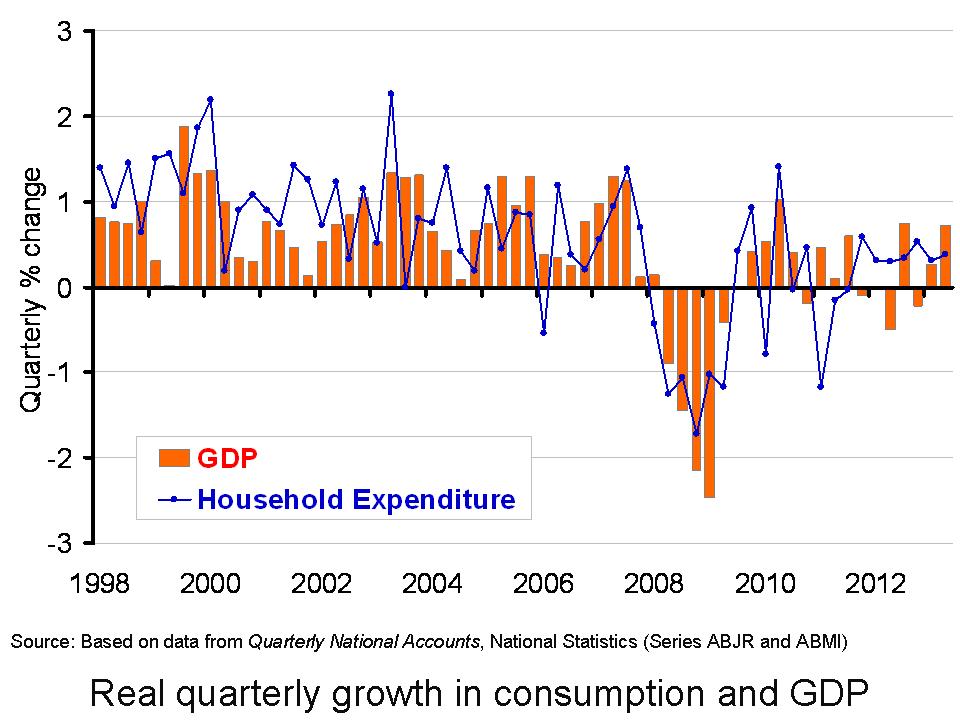 The chart helps to demonstrate the stark turnaround in the growth in consumer spending. Over the period from 2008 Q1 to 2011 Q3, real consumer spending typically fell by 0.4 per cent each quarter. As we noted in our previous blog, this was a period when the global financial system was in distress, with the availability of credit severely dampened, but also a period when households were concerned about their own financial balances and the future prospects for growth. Over the same period, real GDP typically fell by a little under 0.3 per cent each quarter. (Click here to download a PowerPoint of the chart.)
The chart helps to demonstrate the stark turnaround in the growth in consumer spending. Over the period from 2008 Q1 to 2011 Q3, real consumer spending typically fell by 0.4 per cent each quarter. As we noted in our previous blog, this was a period when the global financial system was in distress, with the availability of credit severely dampened, but also a period when households were concerned about their own financial balances and the future prospects for growth. Over the same period, real GDP typically fell by a little under 0.3 per cent each quarter. (Click here to download a PowerPoint of the chart.)
The real value of consumer spending has yet to return to its 2007 Q4 peak (£242 billion at 2010 prices). In 2013 Q2 the real value of consumer spending is estimated still to be 3 per cent below this level (£235 billion at 2010 prices). These figures are mirrored by the economy at large. Real GDP peaked in 2008 Q1 (£393 billion at 2010 prices). Despite the back-to-back quarterly increases in real GDP of 0.3 per cent in Q1 and 0.7 per cent in Q2, output in 2013 Q2 (£380 billion at 2010 prices) remains 3.2 per cent below the 2008 Q1 peak.
While real consumption values are below their 2007 Q4 peak, the concern is whether current rates of growth in consumer spending are sustainable. In particular, should this growth cause the household sector financial distress there would be real pain for the economy further down the line. Some commentators argue that the latest GDP figures are consistent with a more balanced recovery. In Q2 economic growth was supported too by other parts of the economy. For instance, we saw a 3.6 per cent rise in export volumes and a 1.7 per cent rise in gross fixed capital formation (i.e. investment expenditure).
Nonetheless, it is the protracted period over which consumer spending has been growing robustly that concerns some economists. Hence, we will need to continue to monitor the growth in all components of aggregate demand and, in particular, changes in household consumption, income, saving and borrowing.
Data
Second Estimate of GDP, Q2 2013 Dataset Office for National Statistics
Articles
New articles
UK economic growth revised up to 0.7% BBC News, (23/8/13)
UK GDP revised up to 0.7pc in second quarter: reaction Telegraph, (23/8/13)
UK rallying faster than thought as exports leap boosts GDP Independent, Russell Lynch and Ben Chu (24/8/13)
UK economy expanding faster than first thought, GDP revision shows Guardian, Heather Stewart (23/8/13)
Growth upgrade points to ‘sustainable’ recovery Telegraph, Philip Aldrick (23/8/13)
Previous articles
UK wages decline among worst in Europe BBC News, (11/8/13)
Squeezing the hourglass The Economist, (10/8/13)
UK first-quarter growth unchanged BBC News, (28/5/13)
Summer heatwave triggers shopping spree in ‘Wongaland’ economy Telegraph, Steve Hawkes and Steven Swinford (15/8/13)
Retail sales data better than expected as UK economy enjoys summer bounce Guardian, Heather Stewart (15/8/13)
Mark Carney is banking on you to keep spending Telegraph, Philip Aldrick (10/8/13)
NIESR upgrades UK economy but warns on consumer spending Telegraph, Philip Aldrick (2/8/13)
Consumers ‘expect better economy’ Belfast Telegraph, (4/8/13)
Questions
- Explain what you understand by a ‘sustainable’ economic recovery.
- What are the expenditure components that make up Aggregate Demand?
- Explain what you understand by consumption smoothing.
- Why would we would typically expect consumption growth to be less variable than that in disposable income?
- Would we expect consumption growth to always be less variable than that in disposable income? Explain your answer.
- What impact do you think the financial crisis has had on consumer behaviour?
- To what extent do you think the current growth in consumer spending is sustainable?
- How important are expectations in determining consumer behaviour?
 Household spending makes up about two-thirds of aggregate demand in the UK. Understanding its determinants is therefore important to understanding short-term economic growth. The real value of consumer spending by British households has risen in each quarter since 2011 Q4. Over the same period real disposable income has flat-lined. This suggests that the British household sector has stepped up attempts to smooth their longer-term spending profile despite the current absence of growth in their real incomes.
Household spending makes up about two-thirds of aggregate demand in the UK. Understanding its determinants is therefore important to understanding short-term economic growth. The real value of consumer spending by British households has risen in each quarter since 2011 Q4. Over the same period real disposable income has flat-lined. This suggests that the British household sector has stepped up attempts to smooth their longer-term spending profile despite the current absence of growth in their real incomes.
When viewed over many years, disposable income and consumer spending grow at very similar rates. After stripping out inflation we find that over the past 50 years both have grown at about 2½ per cent per annum. However, if we measure growth from one quarter of the year to the next we tend to find that consumption growth is less variable than disposable income. This is known as consumption smoothing.
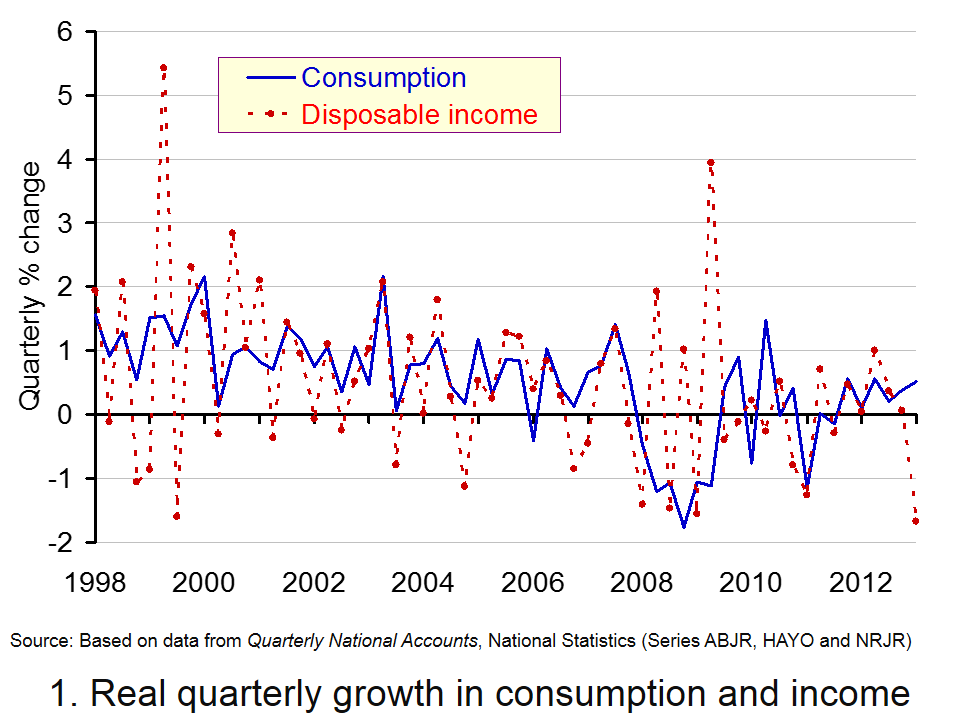 Chart 1 shows the quarterly percentage change in consumption and disposable income since 1998. (Click here to download a PowerPoint of the chart).The variability in the disposable income series is generally greater than that in consumption so helping to illustrate consumption smoothing.
Chart 1 shows the quarterly percentage change in consumption and disposable income since 1998. (Click here to download a PowerPoint of the chart).The variability in the disposable income series is generally greater than that in consumption so helping to illustrate consumption smoothing.
Consumption smoothing is facilitated by the financial system enabling us to either borrow to supplement our spending or to save to enjoy more spending in the future. The financial system can help households to avoid large variations in their spending over short periods.
Consumption smoothing does not prohibit falls in consumption nor periods when it is more variable than income. Over the period from 2008 Q1 to 2011 Q3, real consumption typically fell by 0.4 per cent each quarter while disposable income was flat. This was a period when the global financial system was in distress. Sharp contractions in credit meant that the financial system was no longer able to support economic activity as it had previously. Furthermore, households too looked to repair their balance sheets with economic uncertainty acting as an incentive to do so.
What is interesting is the extent to which British households are spending again. Since 2011 Q4 the real value of spending has typically expanded by 0.4 per cent each quarter while income growth remains largely absent. One might argue that this just demonstrates a willingness for households to engage in consumption smoothing. With credit conditions still tight, the growth in spending has been aided by a decline in the saving ratio. 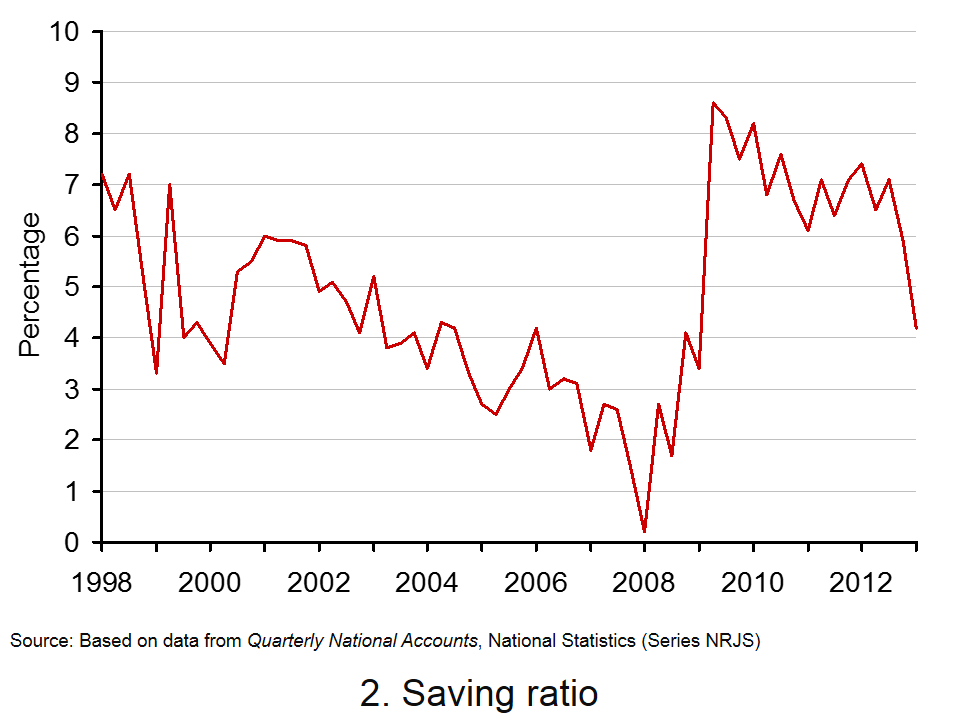 This can be seen from Chart 2.
This can be seen from Chart 2.
In 2009 Q2 the proportion of income saved hit 8.6 per cent having been as low as 0.2 per cent in 2008 Q1. In 2013 Q1 the saving ratio had fallen back to 4.2 per cent. (Click here to download a PowerPoint of the chart.)
It is of course all too easy to over-interpret data. Nonetheless, there be will concern if households look to maintain consumption growth at rates substantially greater than those in disposable income for too long a period of time. Consumption smoothing could become a real problem for future economic activity if it was to result in a financially distressed household sector. Hence, an important question is the extent to which current rates of consumption growth are sustainable. Future consumption and income trends will therefore be analysed with enormous interest.
Data
Quarterly National Accounts, Q1 2013 Dataset Office for National Statistics
Articles
UK wages decline among worst in Europe BBC News, (11/8/13)
Squeezing the hourglass The Economist, (10/8/13)
UK first-quarter growth unchanged BBC News, (28/5/13)
Summer heatwave triggers shopping spree in ‘Wongaland’ economy Telegraph, Steve Hawkes and Steven Swinford (15/8/13)
Retail sales data better than expected as UK economy enjoys summer bounce Guardian, Heather Stewart (15/8/13)
Mark Carney is banking on you to keep spending Telegraph, Philip Aldrick (10/8/13)
NIESR upgrades UK economy but warns on consumer spending Telegraph, Philip Aldrick (2/8/13)
Consumers ‘expect better economy’ Belfast Telegraph, (4/8/13)
Questions
- Explain what you understand by consumption smoothing.
- Why would we would typically expect consumption growth to be less variable than that in disposable income?
- Would we expect consumption growth to always be less variable than that in disposable income? Explain your answer.
- What impact do you think the financial crisis has had on consumer behaviour?
- To what extent do you think the current growth in consumer spending is sustainable?
- How important are expectations in determining consumer behaviour?
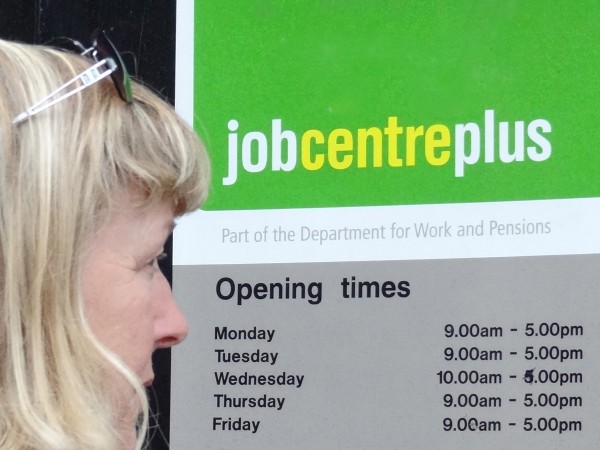 UK unemployment fell by 4000 to 2.51 million in second quarter of this year. But this was too small to have any significant effect on the unemployment rate, which remained at 7.8%.
UK unemployment fell by 4000 to 2.51 million in second quarter of this year. But this was too small to have any significant effect on the unemployment rate, which remained at 7.8%.
According to the forward guidance issued by the Bank of England, Bank Rate will stay at 0.5%, barring serious unforeseen circumstances, until unemployment reaches 7%. So will this be soon?
There are good reasons to suggest that the answer is no. Reasons include the following:
(a) Many firms may choose to employ their part-time workers for more hours, rather than taking on extra staff, if the economy picks up.
 (b) The recovery is being fuelled by a rise in consumption, which, in turn, is being financed by people drawing on savings or borrowing more. The household saving ratio fell from 7.4% in 2012 Q1 to 4.2% in 2013 Q1. This trend will be unsustainable over the long run, especially as the Bank of England may see a rapid rise in borrowing/decline in saving as serious enough to raise interest rates before the unemployment rate has fallen to 7%.
(b) The recovery is being fuelled by a rise in consumption, which, in turn, is being financed by people drawing on savings or borrowing more. The household saving ratio fell from 7.4% in 2012 Q1 to 4.2% in 2013 Q1. This trend will be unsustainable over the long run, especially as the Bank of England may see a rapid rise in borrowing/decline in saving as serious enough to raise interest rates before the unemployment rate has fallen to 7%.
(c) Despite the modest recovery, people’s average real incomes are well below the levels prior to the deep recession of 2008/9.
The articles consider the outlook for the economy and unemployment
Articles
UK unemployment holds steady at 7.8pc The Telegraph, Rebecca Clancy (14/8/13)
Unemployment rate is unlikely to fall sharply The Guardian, Larry Elliott (14/8/13)
UK unemployment falls by 4,000 to 2.51 million BBC News (14/8/13)
UK wages decline among worst in Europe BBC News (11/8/13)
Squeezing the hourglass The Economist (10/8/13)
 More people in work than ever before as unemployment falls Channel 4 News, Faisal Islam (14/8/13)
More people in work than ever before as unemployment falls Channel 4 News, Faisal Islam (14/8/13)
Data
Labour Market Statistics, August 2013 ONS
United Kingdom National Accounts, The Blue Book, 2013: Chapter 06: Households and Non-profit Institutions Serving Households (NPISH) ONS
Questions
- What factors determine the rate of unemployment?
- With reference to the ONS data in Labour Market Statistics, August 2013 above, what has happened to (a) the long-term unemployment rate; (b) the unemployment rate for 18–24 year olds?
- How would you define ‘living standards’?
- How is labour productivity relevant to the question of whether unemployment is likely to fall?
- How much have living standards fallen since 2008?
- Under what circumstances might the Bank of England raise interest rates before the rate of unemployment has fallen to 7%?
- Property prices are beginning to rise. Consider the effects of this and whether, on balance, a rise in property prices is beneficial.
 A few weeks ago, Elizabeth wrote a blog on the payday loan industry and its referral by the OFT to the Competition Commission (see A payday inquiry). Now the Archbishop of Canterbury, Justin Welby, has joined the debate. He suggests that the problem of sky-high interest rates charged by payday loan companies would be tackled better by increased competition from elsewhere in the industry than by regulation.
A few weeks ago, Elizabeth wrote a blog on the payday loan industry and its referral by the OFT to the Competition Commission (see A payday inquiry). Now the Archbishop of Canterbury, Justin Welby, has joined the debate. He suggests that the problem of sky-high interest rates charged by payday loan companies would be tackled better by increased competition from elsewhere in the industry than by regulation.
In particular, he proposes an expansion of credit unions. These could provide a much cheaper alternative for people in financial difficulties who are seeking short-term loans. He would like church members with relevant skills to volunteer at credit unions and proposes setting up local credit unions operated from church buildings.
* * * * * * * * * *
In this news item we hand over to ‘Kostas Economides’, an imaginary lecturer in Economics at the imaginary ‘University of the South of England’. Kostas’s blog is written by Guy Judge. Guy recently retired from the University of Portsmouth, where he was Deputy Head of Department, and is now a Visiting Fellow.
 In his blog, Kostas frequently reflects on various economic issues, as well as on life at USE. Here he recounts a conversation with his colleagues about Justin Welby’s proposals. They consider various implications of the proposals from an economist’s point of view.
In his blog, Kostas frequently reflects on various economic issues, as well as on life at USE. Here he recounts a conversation with his colleagues about Justin Welby’s proposals. They consider various implications of the proposals from an economist’s point of view.
Kostas’s blog
Pay day loans Guy’s Other Stuff, Guy Judge (30/7/13)
To provide some background to Kostas’s blog, you’ll see below the normal set of links to newspaper articles.
We may well return to Kostas in the near future, as he is planning to look at a number of topical economic issues.
Articles
Why I support Justin Welby’s battle with Wonga The Telegraph, Jacob Rees-Mogg (30/7/13)
 Church plans to compete with payday lender Wonga BBC News, Robert Piggott (25/7/13)
Church plans to compete with payday lender Wonga BBC News, Robert Piggott (25/7/13)
Archbishop of Canterbury wants to ‘compete’ Wonga out of existence The Guardian, Miles Brignall (25/7/13)
Let the payday lenders prosper, but not extort Financial Times (30/7/13)
Coalition will support Archbishop of Canterbury Justin Welby’s plan for credit unions, says Vince Cable Independent, Andrew Grice (28/7/13)
Former Archbishop Rowan Williams backs action against payday loan firms Cambridge News, Jennie Baker (30/7/13)
Why Justin Welby’s vision of kumbayah capitalism is wrong The Telegraph, James Quinn (25/7/13)
Wonga V The Church: Comparing Interest Rates Of Payday Loans And Credit Unions The Huffington Post, Tom Moseley (25/7/13)
Wonga Warned Church Of England Could ‘Compete’ It Out Of Existence The Huffington Post, Tom Moseley (25/7/13)
Credit unions thriving even before Archbishop Welby’s attack on Wonga The Guardian, Rupert Jones (29/7/13)
Questions
- Find out the monthly interest rates being charged by various payday loan companies. Take one loan company as an example and calculate what would happen to your debt over the course of a year if you borrowed £100 and paid nothing back each month. What would be the annualised rate of interest?
- What are the arguments for and against banning payday loan companies?
- What are the arguments for and against imposing an interest rate cap on such companies?
- What are the differences between credit unions and banks?
- Should the interest rates charged by credit unions be uncapped?
- Explain what is meant by ‘moral hazard’ and give some examples. What moral hazard would there be in placing a limit on the number of months over which a debt could go on accumulating?
- How would you decide what a ‘normal’ rate of interest should be? Should this vary with the risk of default and, if so, by how much?
 House prices in the UK are rising and the rise seems to be accelerating – at least until the latest month (August). They are now growing at an annualised rate of nearly 4%. This is the fastest rate for three years (see chart below: click here for a PowerPoint of the chart).
House prices in the UK are rising and the rise seems to be accelerating – at least until the latest month (August). They are now growing at an annualised rate of nearly 4%. This is the fastest rate for three years (see chart below: click here for a PowerPoint of the chart). The problem is that, under the recently issued forward guidance, the Bank of England is set to retain the current historically low Bank rate of 0.5% until unemployment has fallen to 7%. But that could be some time – probably around two years.
The problem is that, under the recently issued forward guidance, the Bank of England is set to retain the current historically low Bank rate of 0.5% until unemployment has fallen to 7%. But that could be some time – probably around two years.







